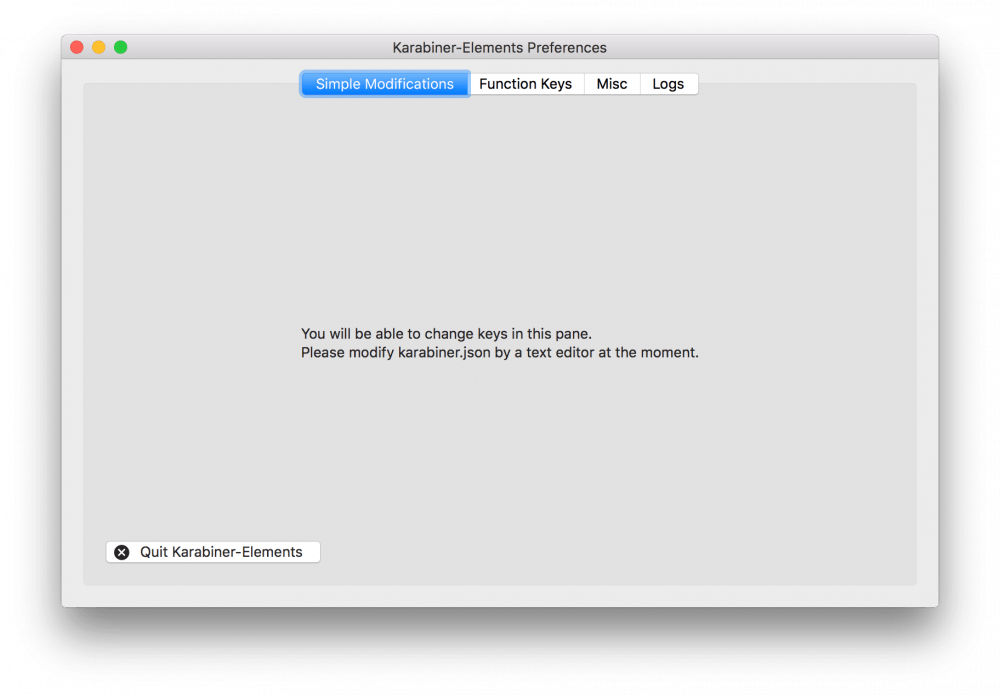

- #KARABINER ELEMENTS NOT WORKING MOJAVE UPDATE#
- #KARABINER ELEMENTS NOT WORKING MOJAVE PORTABLE#
- #KARABINER ELEMENTS NOT WORKING MOJAVE SOFTWARE#
- #KARABINER ELEMENTS NOT WORKING MOJAVE PC#
- #KARABINER ELEMENTS NOT WORKING MOJAVE MAC#
#KARABINER ELEMENTS NOT WORKING MOJAVE PC#
PC users will be pleased to know the keyboard works straight out of the box, all you need to do is plug the keyboard in and you're good to go. Please note if you just need a 'Mac' or a 'PC' keyboard we recommend our backlit keyboards.


#KARABINER ELEMENTS NOT WORKING MOJAVE MAC#
It was important that the keyboard worked perfectly once installed on a Mac or PC just like a standard keyboard for that operating system.
#KARABINER ELEMENTS NOT WORKING MOJAVE SOFTWARE#
With most audio and video software now available on Mac and PC, users wanted a new type of keyboard which they could use across all systems. The Slimline hybrid keyboard has been our most requested product. Thank you for choosing Editors Keys for your new Hybrid Mac & PC Keyboard Slimline Keyboard. Mac Keyboard Covers Protection and Shortcuts in one
#KARABINER ELEMENTS NOT WORKING MOJAVE PORTABLE#
#Karabiner elements mojave portableĬoncentrations of twenty-seven elements, including naturally-occurring water-quality contaminants arsenic, chromium, and uranium, were measured in 217 samples of alluvium and rock from the western Mojave Desert, southern California, using portable (pXRF) and laboratory (LXRF) X-ray fluorescence.Backlit Keyboards Wired and Wireless available Results suggest pXRF survey data are sufficiently accurate to assess regional geochemical differences in geologic-source terrains.Ĭomparison of measurements with NIST-traceable standards was good, although pXRF overestimated iron compared to LXRF. Principal component analysis showed rubidium and potassium were associated with alluvium eroded from felsic terrain, while iron, copper, chromium, and to a lesser extent titanium, manganese, and nickel were associated with alluvium eroded from mafic terrain.

Zinc, vanadium, and arsenic were associated with alluvium eroded from hydrothermal terrain. Elemental assemblages associated with different source terrains were traced spatially to identify the source and composition of alluvium composing aquifers pumped for water supply. Changes in geologic source terrain to the Mojave River, associated with movement along the San Andreas Fault over the past one to five million years, reduced the mafic fraction and increased the felsic fraction of alluvium deposited to the regionally important floodplain aquifer along the Mojave River-lowering chromium concentrations in alluvium through geologic time.
#KARABINER ELEMENTS NOT WORKING MOJAVE UPDATE#
I am running the latest update Mojave on a late 2013 27" iMac and VMWare Version 11.0.3 (12992109) What worked for me: Comparison of pXRF and sequential extraction data from 40 samples showed arsenic and uranium were more abundant on the surfaces of mineral grains, while chromium and vanadium remained mostly within unweathered mineral grains-suggesting arsenic and uranium may be more readily mobilized into groundwater with changes in pH, redox, or ionic strength than chromium or vanadium.I had the the same problem, and tried the steps recommended by other users such as uninstalling and re-installing, going to System Preferences, ensuring Full Disk Access and Accessibility is allowed. Check this directory in Terminal: /Library/StagedExtensions/Applications/VMware Fusion.app/Contents/Library/kexts.If you see all the VMWare kexts there, then follow the steps below.You will not be able to delete these even with sudo Make sure your Macintosh HD (or main HD) is mounted (check in Disk Utiltiy).StagedExtensions/Applications/VMware\ Fusion.app This will not be automatically mounted if you are using APFS with encryption. The broken pipe error should now be fixed. The reason this is happening is that in the later versions of Mojave, the kexts are blocked and moved to StagedExtensions instead of being installed. I tried all the other responses I saw in here (Allow in Security & Privacy, allow full disk access, try different things in recovery terminal, etc.) but my issue turned out to be maxing out the number of kernel extensions that can be loaded (at least this is my understanding). I ran 'kextstat' and found some to remove (all virtualbox kext's in my case). If you only see 2 or less kext's, run 'sudo kextutil /Applications/VMware\ Fusion.app/Contents/Library/kexts/vmmon.kext' As soon as I freed up some slots, all my VM's began working again in VMware.Īgain, this is a little outside my expertise so I'm paraphrasing assistance I got, but essentially they told me there are only a certain number of slots for kext's to be running and VMware needed more slots than what I had available on my machine. if you see something like 'Failed to load /Library/StagedExtensions/Applications/VMware Fusion.app/Contents/Library/kexts/vmmon.kext - (libkern/kext) kext (kmod) start/stop routine failed.', this is probably your fix run 'sudo kextunload -b /whatever/kext/you/can/remove' (i.e. I spent a long time trying to tackle the same problem after I upgraded from High Sierra to Mojave.


 0 kommentar(er)
0 kommentar(er)
